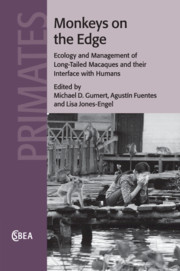Book contents
- Frontmatter
- Contents
- List of contributors
- Foreword
- Preface
- Acknowledgements
- Part I The status and distribution of long-tailed macaques
- Part II The human–macaque interface
- Part III Ethnophoresy of long-tailed macaques
- Part IV Comparisons with rhesus macaques
- Part V Understanding and managing the human–macaque interface
- 12 Developing sustainable human–macaque communities
- 13 Future directions for research and conservation of long-tailed macaque populations
- Index
- References
13 - Future directions for research and conservation of long-tailed macaque populations
from Part V - Understanding and managing the human–macaque interface
Published online by Cambridge University Press: 16 May 2011
- Frontmatter
- Contents
- List of contributors
- Foreword
- Preface
- Acknowledgements
- Part I The status and distribution of long-tailed macaques
- Part II The human–macaque interface
- Part III Ethnophoresy of long-tailed macaques
- Part IV Comparisons with rhesus macaques
- Part V Understanding and managing the human–macaque interface
- 12 Developing sustainable human–macaque communities
- 13 Future directions for research and conservation of long-tailed macaque populations
- Index
- References
Summary
Long-tailed macaques are an edge species, preferring to live along the forest borders of many habitat types (Gumert, Chapter 1). The result of this preference is that long-tailed macaques are adaptable generalists that are frequently found along the edges of human settlements across Southeast Asia. Another consequence is that long-tailed macaques can adjust quickly to living with other species, and thus have commonly expanded beyond the edge to overlap with humans in numerous contexts (see Part II). Due to the close association with humans, macaque populations can be powerfully impacted by human activity. In some cases they have been carried and introduced to areas beyond their normal range (see Part III). The overlap of macaques and humans, and the consequences of this overlap, needs to be better understood. While the basis of our relationship with long-tailed macaques is becoming apparent, much more research will be needed to fully understand their population and the causes and consequences of our interface with them. This chapter is an attempt to focus future research in a few important areas that will be necessary for better understanding the population, ecology, and synanthropic nature of long-tailed macaques. This chapter focuses on three subject areas that warrant special consideration for future scientific research on M. fascicularis: population-level research, the issue of ethnophoresy and introduced populations, and the causes and consequences of human-macaque overlap.
Directions for population-level research
Long-tailed macaques perhaps have the greatest amount of intraspecific variation of any primate species (Fooden, 2006).
- Type
- Chapter
- Information
- Monkeys on the EdgeEcology and Management of Long-Tailed Macaques and their Interface with Humans, pp. 328 - 353Publisher: Cambridge University PressPrint publication year: 2011
References
- 6
- Cited by

